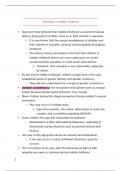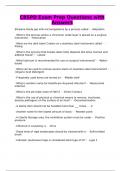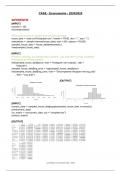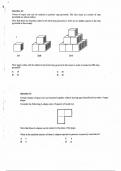Sexuality in middle childhood
Sigmund Freud believed that middle childhood is a period of sexual
latency during which children show no or little interest in sexuality.
o It is now known that the sexual development of children and
their interest in sexuality continue uninterruptedly throughout
childhood.
o The latency theory was based on the fact that children in
middle childhood tend to be more undercover (or covert
concerning their sexuality, to meet social expectations.
Therefore, their sexuality is less observable, especially
by adults.
By the end of middle childhood, children usually have a firm and
established sense of gender identity and gender constancy.
o They will also understand the concept of gender consistency.
Gender consistency: The recognition that gender does oy change
simply because gender-typed behaviour may change.
Many children during this stage are aware of issues related to sexual
orientation.
o This may occur in multiple ways.
Input from parents, the media, observation of same-sex
couples, and counselling regarding AIDS/HIV.
Some children this age will masturbate for pleasure.
o Masturbation is often self-soothing behaviour, especially in
emotionally taxing situations such as parental discord and
divorce.
Sex play in this age group serves as curiosity and exploration.
o If sex play occurs in early childhood should be cause for
concern.
The occurrence of sex play with the Same-sex as well as with
opposite-sex peers is common during middle childhood.
1
, If a child is involved in sex play with a same-sex child, it does not
indicate sexual orientation.
o In most cases, sex play at this age is still rooted more in
curiosity than it is in sexual attraction or pleasure.
o If there are signs of coercive behaviour, and if a child is
uncomfortable about sexual behaviour perpetrated by a
friend, this should be investigated and could be a sign of
sexual bullying.
It is important to educate children at this stage about sexual
reproduction to prevent misconceptions.
Concerning sexual behaviour:
o The behaviour is beyond the child's developmental stage.
o It occurs frequently.
o It interferes with the child's social and cognitive development.
o It involves threats, pressure, force, coercion, or aggression.
o It occurs between children of widely different ages, or
cognitive or developmental abilities.
o The child does not stop the behaviour when redirected by an
adult.
o It causes strong emotional responses in the child, like anger or
anxiety.
o It causes changes in the child's typical behaviours, interests,
or activities.It involves inappropriate or unsafe use of sexual
body parts (e.g., inserting objects into sexual body parts).
2
,Cognitive development
Major cognitive advances occur between the ages of 6 and 12.
o Patterns and habits established during this time will affect the
experience in adolescence and adulthood.
Piaget’s Theory: Concrete Operational Stage
The concrete operational stage spans ages 7-11 and signifies the
stage in which children start using mental operations to solve
problems and reason.
o Mental operations: Strategies and rules that make thinking
more systematic and powerful.
Some mental operations apply to numbers such as
addition, subtraction, multiplication, and division.
Some apply to categories of objects or spatial relations
among objects.
Piaget believed the most critical operation was reversibility.
o Reversibility: The understanding that physical actions and
mental operations may be reversed.
o Each operation has an inverse that may undo or reverse the
effects of the operation.
Eg. If you begin with 5 and add 3 you get 8, by subtracting
3 from 8, you reverse your steps and return to 5.
The understanding of the basic reversibility of actions lies behind
many of the cognitive gains made during middle childhood.
The ability to understand hierarchies of classes (Bruno = Labrador =
dog = Animal) rests on the ability to move both ways in thinking
about relationships.
Reversible mental operations allow concrete operational children to
perform the conservation task.
3
, o Concrete operational thinkers understand that if the
transformation were reversed, the objects would be identical.
Children do not master all conservation types at the same time.
o They do not readily transfer what they have learnt about one
type of conservation to another type, even though the
underlying principles are the same.
Known as Horizontal Decalage.
Concrete operational thinking is more powerful than preoperational
thinking.
o Preoperational children are egocentric, centred in their thinking
and confuse appearance with reality.
o In the concrete operational stage, egocentrism diminishes as
children have more experiences with others that assert their
own perspectives on the world.
Children learn to decentre.
o They learn that events may be interpreted in diverse ways that
help children realise that many problems have many facets and
that appearances can be deceptive.
Concrete operational thinking is limited to the tangible and the real.
o Thinking abstractly and hypothetically is beyond the ability of
concrete operational thinkers.
How applicable is this theory today?
o Piaget maintained that the mastery of skills such as
conservation depends on neurological maturation and
adaptation to the environment and is not tied to cultural
experience.
o Piaget's descriptions of the changes that occur during middle
childhood generally have been maintained well.
Cross-cultural studies support a progression from the rigid,
illogical thinking of younger children to the flexible, logical
thinking of older children.
o Piaget may not have paid enough attention to the role of
culture-based experience.
4
Sigmund Freud believed that middle childhood is a period of sexual
latency during which children show no or little interest in sexuality.
o It is now known that the sexual development of children and
their interest in sexuality continue uninterruptedly throughout
childhood.
o The latency theory was based on the fact that children in
middle childhood tend to be more undercover (or covert
concerning their sexuality, to meet social expectations.
Therefore, their sexuality is less observable, especially
by adults.
By the end of middle childhood, children usually have a firm and
established sense of gender identity and gender constancy.
o They will also understand the concept of gender consistency.
Gender consistency: The recognition that gender does oy change
simply because gender-typed behaviour may change.
Many children during this stage are aware of issues related to sexual
orientation.
o This may occur in multiple ways.
Input from parents, the media, observation of same-sex
couples, and counselling regarding AIDS/HIV.
Some children this age will masturbate for pleasure.
o Masturbation is often self-soothing behaviour, especially in
emotionally taxing situations such as parental discord and
divorce.
Sex play in this age group serves as curiosity and exploration.
o If sex play occurs in early childhood should be cause for
concern.
The occurrence of sex play with the Same-sex as well as with
opposite-sex peers is common during middle childhood.
1
, If a child is involved in sex play with a same-sex child, it does not
indicate sexual orientation.
o In most cases, sex play at this age is still rooted more in
curiosity than it is in sexual attraction or pleasure.
o If there are signs of coercive behaviour, and if a child is
uncomfortable about sexual behaviour perpetrated by a
friend, this should be investigated and could be a sign of
sexual bullying.
It is important to educate children at this stage about sexual
reproduction to prevent misconceptions.
Concerning sexual behaviour:
o The behaviour is beyond the child's developmental stage.
o It occurs frequently.
o It interferes with the child's social and cognitive development.
o It involves threats, pressure, force, coercion, or aggression.
o It occurs between children of widely different ages, or
cognitive or developmental abilities.
o The child does not stop the behaviour when redirected by an
adult.
o It causes strong emotional responses in the child, like anger or
anxiety.
o It causes changes in the child's typical behaviours, interests,
or activities.It involves inappropriate or unsafe use of sexual
body parts (e.g., inserting objects into sexual body parts).
2
,Cognitive development
Major cognitive advances occur between the ages of 6 and 12.
o Patterns and habits established during this time will affect the
experience in adolescence and adulthood.
Piaget’s Theory: Concrete Operational Stage
The concrete operational stage spans ages 7-11 and signifies the
stage in which children start using mental operations to solve
problems and reason.
o Mental operations: Strategies and rules that make thinking
more systematic and powerful.
Some mental operations apply to numbers such as
addition, subtraction, multiplication, and division.
Some apply to categories of objects or spatial relations
among objects.
Piaget believed the most critical operation was reversibility.
o Reversibility: The understanding that physical actions and
mental operations may be reversed.
o Each operation has an inverse that may undo or reverse the
effects of the operation.
Eg. If you begin with 5 and add 3 you get 8, by subtracting
3 from 8, you reverse your steps and return to 5.
The understanding of the basic reversibility of actions lies behind
many of the cognitive gains made during middle childhood.
The ability to understand hierarchies of classes (Bruno = Labrador =
dog = Animal) rests on the ability to move both ways in thinking
about relationships.
Reversible mental operations allow concrete operational children to
perform the conservation task.
3
, o Concrete operational thinkers understand that if the
transformation were reversed, the objects would be identical.
Children do not master all conservation types at the same time.
o They do not readily transfer what they have learnt about one
type of conservation to another type, even though the
underlying principles are the same.
Known as Horizontal Decalage.
Concrete operational thinking is more powerful than preoperational
thinking.
o Preoperational children are egocentric, centred in their thinking
and confuse appearance with reality.
o In the concrete operational stage, egocentrism diminishes as
children have more experiences with others that assert their
own perspectives on the world.
Children learn to decentre.
o They learn that events may be interpreted in diverse ways that
help children realise that many problems have many facets and
that appearances can be deceptive.
Concrete operational thinking is limited to the tangible and the real.
o Thinking abstractly and hypothetically is beyond the ability of
concrete operational thinkers.
How applicable is this theory today?
o Piaget maintained that the mastery of skills such as
conservation depends on neurological maturation and
adaptation to the environment and is not tied to cultural
experience.
o Piaget's descriptions of the changes that occur during middle
childhood generally have been maintained well.
Cross-cultural studies support a progression from the rigid,
illogical thinking of younger children to the flexible, logical
thinking of older children.
o Piaget may not have paid enough attention to the role of
culture-based experience.
4











